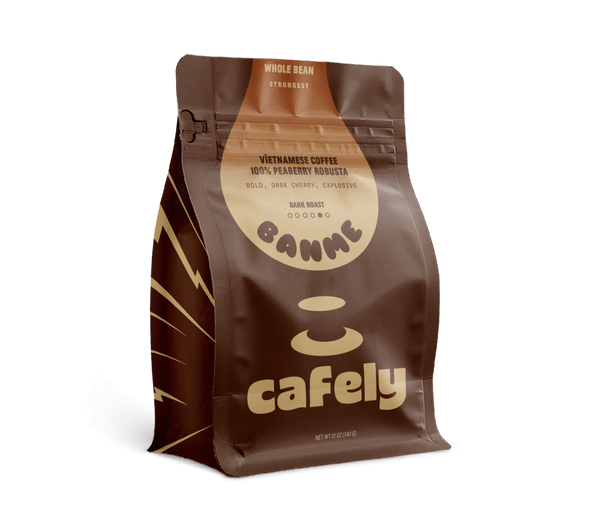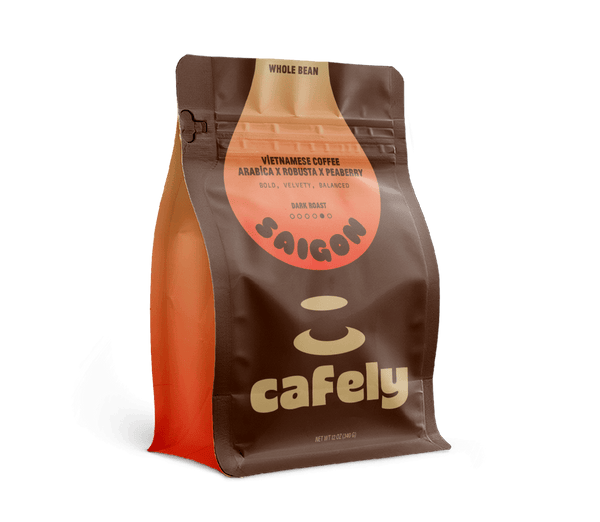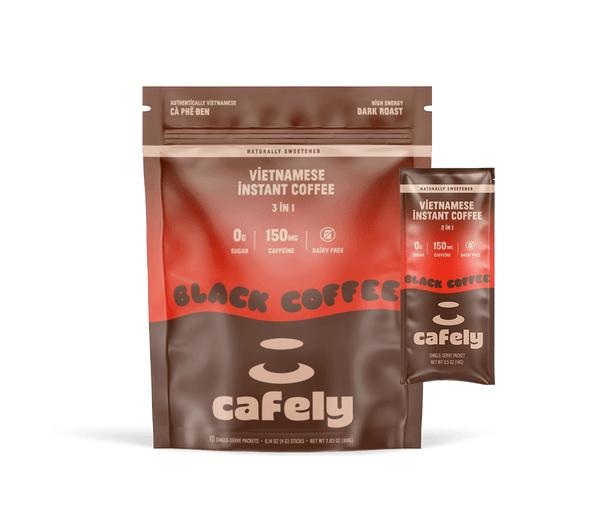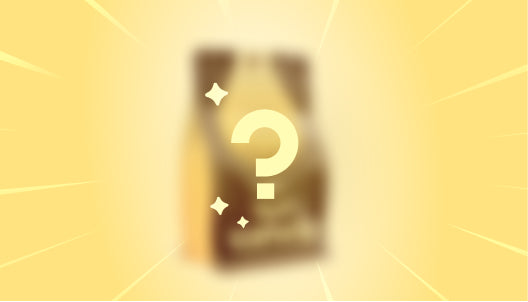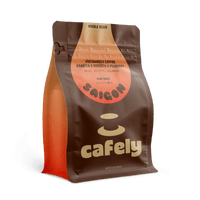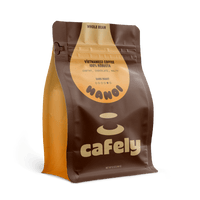French press brewing will do justice to all types of coffee — but it works especially well with medium roasts and arabica or arabica-robusta blends.
This immersion-style brewing device steeps the coffee like a tea, efficiently pulling out all the alkaloids, oils, and flavors. The French press is impressively versatile — users can tweak the strength of their extraction by altering water temperature, coffee-to-water ratio, and extraction time.
Here’s how to select the ideal coffee for a French press and how to optimize brewing depending on the beans you’re using.
Top Recommendations:
- DaLat (100% arabica) — A smooth, aromatic, & fruity coffee, perfect for French press brewing.
- DaNang (50/50 robusta/arabica blend) — For those who want something a little stronger and more caffeinated without sacrificing taste.
The Best Types of Coffee For a French Press
The best coffee to use in a French press is typically a medium to dark roast with a coarse grind.
Both arabica and robusta coffee work well with this brewing system, but arabica tends to have the most balanced flavor if you drink your coffee black. Robusta is a great option if you mix your coffee with milk or another sweetener and prefer stronger, bolder, more caffeinated coffee.
We recommend our DaLat 100% arabica or our DaNang 50/50 arabica-robusta medium roast blend for use in a French press.
How to Choose Coffee For a French Press
The main consideration when choosing coffee to use in a French press is the grind, but other factors come into play as well.
Generally speaking, you can use any coffee you want in a French press as long as it isn’t already pre-ground to be medium fine or below.
Selecting By Grind Size
The French press is a very efficient extraction tool. The grounds are completely saturated in water, so the extraction rate is very high. Overextraction with this device is the most common mistake people make — so to combat this problem, a medium or medium-coarse grind is best.
The larger particle size of coarse-ground coffee slows the rate of extraction and prevents the plunger-style filter from getting clogged.
Summary: Only use medium or medium-coarse coffee in a French press.
Selecting By Roast
The roast level is less important when choosing the best coffee to use in a French press, but the roast level you choose may change how the device should be used.
Medium-roast coffees — These coffees are strong enough to provide the deep earthy and chocolaty flavor we know and love but not strong enough to become bitter and overpowering. Medium-roast coffee is also more resistant to over-extraction, which is the main concern to be aware of when brewing with a French press.
Dark roast coffees — These coffees produce a strong, earthy brew. Some people prefer to reduce the steeping time for these coffees to about 4 minutes (instead of 5) to help curb bitterness in these brews. People who like adding milk or sweetener to their coffee may find the French press makes the perfect cup of dark roast coffee.
Check out our premium dark roast arabica: DaLat.
Light roast coffee — These coffees can be used in a French press but are more sensitive to over and under-extraction. We’ve found exactly 4 minutes of extraction and a 1:12 coffee-to-water ratio works best for light roast when using a French press. The French press also has a tendency to highlight acidic flavors in coffee, which is more common in lighter roasts. If you dislike the acidic flavor, opt for a medium or dark roast instead.
Summary: You can use any medium or dark roast coffee in a French press.
Selecting By Species
There are more than 120 different species of coffee around the world — but we use just two for brewing coffee.
Coffea arabica and Coffea robusta are the two most common species of coffee by far.
The French press will brew an excellent cup of coffee from both species but tends to compliment the complex, aromatic, and fruity flavors of arabica a little better.
If you like a strong, caffeinated coffee, opt for a premium arabica-robusta blend — such as our DaNang or SaiGon OG blends.
Summary: Opt for arabica if you want to optimize for taste or a robusta-arabica blend if you want something a little more caffeinated.
Selecting By Origin
The subtle flavors that make different coffees so distinct largely come down to the region in which it was grown.
When selecting coffees for a French press, the best options usually come from places known for having less acidity (for arabica) or places that contain rich volcanic soil (for robusta).
For arabica coffee, countries with a high altitude tend to produce less acidic coffees. This helps avoid a common issue with acidity some users report when using a French press. High altitude coffee origins include Colombia, Ethiopia, and Kenya.
For robusta coffee, countries with rich volcanic soil tend to produce the best coffee in a French press. Robusta tends to be very bitter, but the volcanic soil has a tendency to balance the flavor with more nutty and chocolatey notes. Volcanic coffee origins include Vietnam, Indonesia, and Brazil.
Summary: Aim for coffees from high-altitude countries for a less acidic cup.
Coffee to Avoid Using in a French Press
The French press is surprisingly forgiving. If you find the coffee is too dark and bitter, you can simply use less coffee or shorten the extraction time for the next batch. If it’s too weak, simply bump the amount of coffee you’re using and/or increase the extraction time.
There are a few weaknesses of this device that can help us identify coffees that don’t tend to work as well with this brewing device:
- Highly acidic coffees — The French press tends to emphasize acidity in coffee, so if you dislike this quality we recommend looking for a low-acid coffee or stick to dark roast or robusta.
- Coffees pre-ground to medium or fine — The only caveat with the French press is the grind size. Medium-fine or fine-ground coffee will clog your press and produce over-extracted, bitter, and astringent coffee.
- Light roast coffee — We're not saying you can't use light roast beans in a French press; you certainly can, but these beans are much more sensitive to underoptimized brewing. If you're new to a French press, we recommend a medium or dark roast instead.
How Does a French Press Work?
Brewing with a French press couldn’t be simpler — grind your coffee to the consistency of sea-salt, add your grounds to the carafe, add your water, wait 5–6 minutes, press the plunger, flavor and enjoy!
Check out our in-depth guide to brewing with a French press here.
Tips For Successful French Press Brewing
The beauty of the French press is its simplicity — add coffee, mix with water, wait for extraction, and strain using the built-in plunger.
That said, there are a few factors to keep in mind to get the best cup possible:
Get the Grind Right
Always use a medium-coarse or coarse grind when brewing with a French press. The consistency should be similar to sea salt.
If buying pre-ground coffee, make sure to check the grind level before you buy. The best option is to buy a small grinder and order whole-bean coffee. This allows you to select the grind you want and maximizes the freshness of the coffee.
A burr grinder is best, but a blade-style grinder works great on a budget.
Coffee-To-Water Ratio For French Press
The best starting point is to use 14 parts water for every 1 part coffee. After the first brew, adjust your ratio to match your preference. If it is too strong, increase it to 16 parts water instead. If you want your coffee even stronger, consider reducing the water to 1:12 or extending the extraction time by up to 1 minute.
Ideal Water Ratios: French Press (Using Standard 2-Cup Press Size)
|
Water-Coffee Ratio |
Coffee |
Water |
|
1:12 |
5–6 tbsp (30 grams) |
1.4 cups (350 grams) |
|
1:14 |
5–6 tbsp (30 grams) |
1.7 cups (400 grams) |
|
1:16 |
5–6 tbsp (30 grams) |
2 cups (500 grams) |
Extraction Time
The best starting point for French press brewing is to let your coffee steep for about 5 or 6 minutes. By then, most of the sediment will settle at the bottom. When you apply the plunger, don't press it all the way down; stop just before the sediment bed to avoid clouding your coffee with fine particulates.
Feel free to experiment with the extraction times, shortening them for a brighter, lighter brew or letting them sit longer for a darker, bolder coffee.
Final Thoughts: What Coffee To Use in a French Press
Any coffee will work in a French press — it’s one of the main features of this classic brewing method.
However, for the best cup possible, we can make a few simple recommendations:
If you drink black coffee, we recommend sticking to a 100% arabica blend, such as a bag of our whole bean DaLat coffee (avoid pre-ground versions) or our medium-roast arabica-robusta blend, DaNang.
We recommend our SaiGon OG (butter-roasted) or our HaNoi (100% robusta) for strong Vietnamese-style coffee mixed with milk or cream.
FAQs: Brewing With a French Press
1. What type of coffee grind is best for a French press?
The best grind for a French press is medium to medium coarse. This grind size allows for optimal extraction without clogging the filter or leading to over-extraction. The consistency should resemble sea salt.
2. Can I use any type of coffee beans in a French press?
Yes, you can use any type of coffee beans in a French press, but medium or dark roast arabica beans are typically recommended for the best balance of flavor and acidity. Arabica-robusta blends can also be used, especially if you prefer a bolder taste or plan to add milk or sweeteners.
3. How long should I let my coffee steep in a French press?
Allow your coffee to steep in a French press for about 5 to 6 minutes. This timing can be adjusted based on personal taste preferences: shorter for a lighter brew and longer for a stronger one.
4. Does origin matter when brewing with a French press?
Coffees from any country will work in a French press, but if you’re brewing with arabica coffee and want something less acidic, go for high-altitude regions like Colombia, Ethiopia, and Kenya. For robusta beans, regions with rich volcanic soil like Vietnam, Indonesia, and Brazil are recommended as they tend to enhance the desirable nutty and chocolatey flavors.
5. How can I prevent my French press coffee from being too bitter?
To prevent bitterness, ensure you're using the correct grind size (medium to medium coarse) and avoid overstepping. If the coffee is consistently too strong or bitter, adjust the coffee-to-water ratio or extraction time. If bitterness persists, consider switching to a different roast or origin that naturally produces a smoother flavor.
